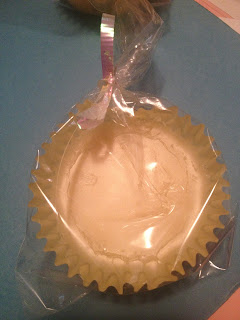Yes. It is. I readily admit I am an omnivore. But if something is going to give its life so that I can eat, I want to make sure I don't waste any of it. You've seen my postings on making bone stock. Well, the same can go for fat.
That being said, if you have ever had REAL pie crust made with good lard, or in bread instead of shortening, I won't need to cajole you. Many store bought lards are partially hydrogenated, which is the BAD fat, or else they include other oils, such as canola. Shortening and margarine are just one step away from being petroleum...do you really want that in your body? If you've been reading my blog for a while, you know my feeling on real food. And lard (as well as tallow--beef's version of lard), my friends, is real food. Yes, its still a fat, but its actually a healthy fat.
 You want pork fat, with little to no meat as possible--seriously, it can affect the flavor. Dice it up as much as you can (I like 1 cm cubes as close as possible) the smaller and more uniform your pieces, the more evenly the oil will be expressed and the more oil you'll get. I've actually read of people putting it through a meat grinder first, but have never tried it.
You want pork fat, with little to no meat as possible--seriously, it can affect the flavor. Dice it up as much as you can (I like 1 cm cubes as close as possible) the smaller and more uniform your pieces, the more evenly the oil will be expressed and the more oil you'll get. I've actually read of people putting it through a meat grinder first, but have never tried it.In a very clean pan, (I use a saucier) you want to cook these at a medium heat, stirring regularly.
**NOTE** Bacon fat is NOT lard! I know, you're likely scratching your head saying 'wait, bacon is pork!'
Yes friends, but it is also smoked pork. If you're lucky and it's artisan, you only have smoke to deal with, but if it's bought, there are all sorts of nitrates, etc in it to 'cure' it. This would not work as baking lard. Keep bacon fat separate if you keep it at all!
 Once you start cooking it, you will see a nice clear looking oil appear. You will want to keep cooking until the fat pieces all look like nicely brown crispy critters. These are called pork cracklins. You can salt them and eat them like chicharrones, (pork rinds--at right) or use them to flavor things like collard greens. If you are the nervous sort, or the sort that doesn't pay as close attention as you know you should, please keep a tight fitting cover nearby, just in case of a grease fire. However, I have to say, I've never had a problem, nor known anyone who has, but it is always better to be safe than sorry.
Once you start cooking it, you will see a nice clear looking oil appear. You will want to keep cooking until the fat pieces all look like nicely brown crispy critters. These are called pork cracklins. You can salt them and eat them like chicharrones, (pork rinds--at right) or use them to flavor things like collard greens. If you are the nervous sort, or the sort that doesn't pay as close attention as you know you should, please keep a tight fitting cover nearby, just in case of a grease fire. However, I have to say, I've never had a problem, nor known anyone who has, but it is always better to be safe than sorry.In a sieve lined with 4-6 layers of cheesecloth, pour the hot grease into a mason jar. Another helpful hint. You really want to use wide mouthed jars for this. Yes, you can pour it into a regular jar, but once it solidifies, are you going to want to fuss with the shoulder of the jar to dig out the lard when measuring?

Me either.
Once cool, cover and put in the fridge. You don't have to keep it there, any cool, dry, dark place will do, I just find it more convenient there. I'd say it'd last forever, but you'll use it up before then. You DO want to make sure there is no water in it, as it can cause it to turn rancid.
This method is sometimes called the 'dry' method. As I previously mentioned, you don't want water in your final product. As long as you watch it closely, it shouldn't be a problem.

The other method is called the, you guessed it, 'wet' method. This requires using water. With pork, you would process it the same, but start the pan with water in it. I find a form of this method easier to use when I make tallow. Saving the fat as it cools on top of the liquid, then reheating and filtering the same as in the hot method.
The wet method does give you more control over the heat, and thus, more leeway in your attention, but you cannot have any water at all left when you strain. Theoretically, it all boils off before then. I know some people swear by it, but if I know even a little water can cause problems, well, I'd rather just skip it.






